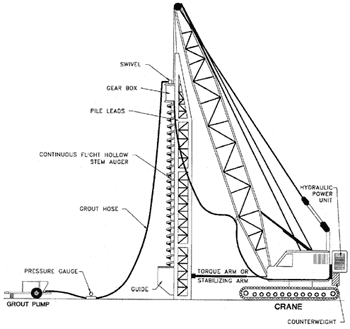US Foundations : Augercast Piling
Common applications for augercast piling are supporting and anchoring tanks, high rise buildings, towers and pools.

Augercast Pile
An augercast pile, often known as a CFA pile, is formed by drilling into the ground with a hollow stemmed continuous flight auger to the required depth or degree of resistance. No casing is required. A high slump concrete mix is then pumped down the stem of the auger. While the concrete is pumped, the auger is slowly withdrawn, lifting the spoil on the flights. A shaft of fluid concrete is formed to ground level. Reinforcement placed by hand is normally limited to 40 feet in depth. Longer reinforcement cages can be installed by a vibrator, or placed prior to pouring concrete if appropriate specialized drilling equipment is used.Augercast piles cause minimal disturbance, and are often used for noise and environmentally sensitive sites. Augercast piles are not generally suited for use in contaminated soils, due to expensive waste disposal costs. In ground containing obstructions or cobbles and boulders, augercast piles are less suitable as damage can occur to the auger. An alternative to augercast piles in contaminated soils areas would be the (GDP) Grout Driven Pile.
The advantages to augercast piling are:
- Less noise - Since auger cast piles are drilled and pumped, there is no use of a hammer to drive piles into the ground. This means no loud hammer impact sounds. This method is useful where noise is an important issue; such is near hospitals or schools and in residential areas.
- No vibration - The vibrations caused by traditional pile-driving methods can cause damage to adjacent structures or nearby heavy equipment. Vibrations can also be a problem for wildlife inhabiting the area, whose normal behaviors such as feeding and mating might be disrupted. This method may be useful in areas where neighboring buildings are close, or in environmentally sensitive areas.
- No casing required - During an auger's installation, the auger is filled with earth. This causes it to maintain the shape of the pile hole while the drilling phase is underway. The pressure of the grout being pumped during the withdrawal and grouting phase is higher than that of the soil pressing in on the hole. The lack of casing may make auger casting a more cost effective method when it can be used.
Augercast Piling is recommended when constructing for large loads, when working with poor soil quality at shallow depth, or when site constraints make other applications impossible.